
|
Special Session SS18
25 June 2019
Star and planet evolution: a journey along with the stellar rotationNews: The detailed program of the session is available in the interactive program of the session. Information for the speakers can be found at the end of this page. See you in Lyon! Aims and scope
During the last 50 years, the stellar rotation has been found to be systemically involved in every physical mechanism implicated in star and planet science, from the formation of star-planet systems up to the generation of magnetic field by dynamo process. Studying the evolution of stellar rotation is thus crucial to understand the evolution and fate of star-planet systems.
Thanks to space observatories (e.g. Kepler/K2), we entered a golden era of improved rotational period measurements that allows for the detection of specific features in the rotation period distribution of open clusters that could trace the footprint left by the interaction of the stars with their close environment, including their possible cortege of planets.
In parallel, the sophistication of the stellar angular momentum and planetary orbital evolution modelling have led to a better understanding of the general behaviour of the physical mechanisms at work in the star-planet systems evolution. Yet, their theoretical description is still being under on-going work.
The goal of this special session is to provide the community with a complete overview of the physical processes linked to the stellar rotation that are involved in star-planet systems' evolution. We aim to reunite European stellar and planetary physicists, asteroseismologists, hydrodynamicists, and observers to discuss the latest constraints and results coming from up-to-date observations and recent numerical modelling.
This workshop comes at a crucial time for the preparation of the future space missions such as PLATO and TESS; and during the peak of the exploitation of the asteroseismic, photometric, and spectroscopic data from Kepler, K2, Gaia (DR2 in April 2018), Gaia-ESO, and APOGEE.
Image credit: NASA, ESA, and G. Bacon (STScI) Source: https://www.spacetelescope.org/images/heic1714a/ CC BY 4.0 Programme
Information for the speakers: The contributed talks are 20 minutes long: the preferred format would be 15+5 minutes The short poster presentation are 5 minutes long: the preferred format would be 3+2 minutes Invited speakers
Scientific organisers Florian Gallet (Grenoble), Nadège Lagarde (Besançon), Louis Amard (Exeter), Émeline Bolmont (Genève) Contact florian.gallet1 @ univ-grenoble-alpes.fr Updated on Mon Jun 10 09:49:38 CEST 2019
|
||||||||||||||
|
European Week of Astronomy and Space Science / The annual meeting of the EAS |
|||||||||||||||
 A power cut will shut down all EAS services on Tuesday, 10 January 2017 starting at 7:30 CET.
A power cut will shut down all EAS services on Tuesday, 10 January 2017 starting at 7:30 CET.





